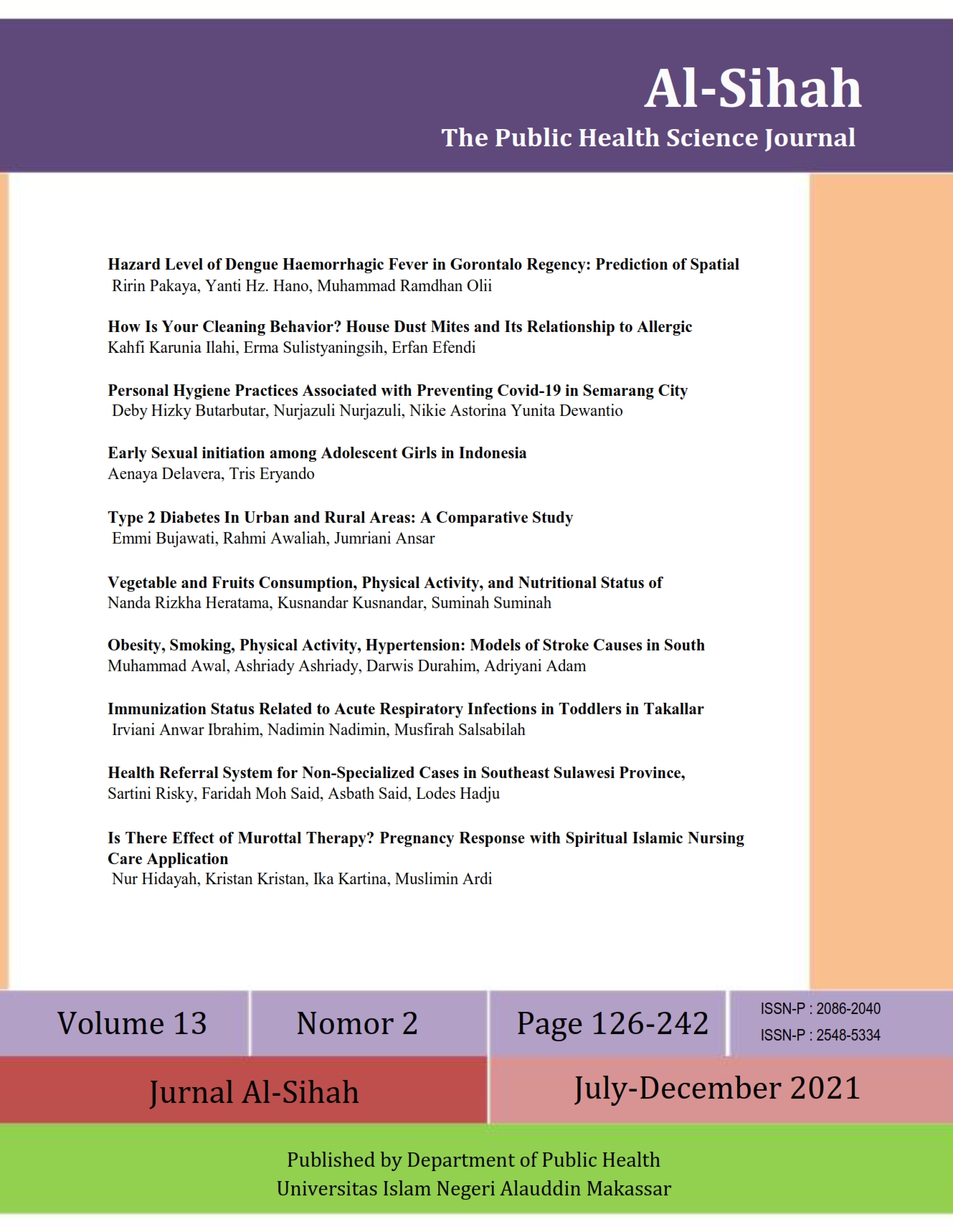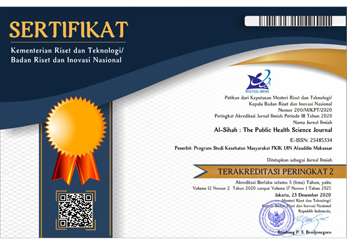Type 2 Diabetes In Urban and Rural Areas: A Comparative Study
DOI:
https://doi.org/10.24252/al-sihah.v13i2.25884Abstract
Diabetes mellitus type 2 is one of the degenerative diseases whose mortality and morbidity rates continue to increase, both in urban and rural areas. Bulukumba Regency is one of the areas with the highest prevalence of type 2 diabetes mellitus. This study aimed to determine the differences in the determinants of the incidence of type 2 diabetes mellitus in urban and rural areas of the Bulukumba Regency in 2021. The type of research used is quantitative with an observational analytic approach and a cross-sectional study design. The population in this study were all people with type 2 diabetes mellitus in urban and rural areas of the Bulukumba Regency. The sample of this study amounted to 210 respondents consisting of 140 respondents in urban areas and 70 respondents in rural areas who were taken using purposive sampling technique with inclusion criteria, namely patients who do not have comorbidities or complications such as coronary heart disease, stroke, and kidney failure as well as patients who are not pregnant at the time of this study. Data were analyzed using the chi-square test. The results of this study indicate that there are differences in consumption of sugar-sweetened beverages (p = 0.032), consumption of fast food (p = 0.044), physical activity (p =0.001), and economic status (p=0.04) of people with type 2 diabetes mellitus in urban and rural areas. Meanwhile, there was no difference in smoking behavior (p=0.404) with type 2 diabetes mellitus in urban and rural areas of the Bulukumba Regency. Management of type 2 diabetes mellitus is important as early as possible so that the morbidity rate due to diabetes can be reduced in the future. The different risk factors between urban and rural areas should be taken into account.
Downloads
References
Alsabieh, M., Alqahtani, M., Altamimi, A., Albasha, A., Alsulaiman, A., Alkhamshi, A., & Bashir, S. (2019). Fast food consumption and its associations with heart rate, blood pressure, cognitive function and quality of life. Pilot study. Heliyon, 5(5), e01566. https://doi.org/10.1016/j.heliyon.2019.e01566
American Diabetes Association. (2019). Classification and diagnosis of diabetes: Standards of Medical Care in Diabetes-2020. Diabetes Care, 43(January), S14–S31. https://doi.org/10.2337/dc20-S002
Arda, Z. A., Hanapi, S., Paramata, Y., & Ngobuto, A. R. (2020). Kualitas Hidup Penderita Diabetes Mellitus dan Determinannya di Kabupaten Gorontalo. Jurnal Promotif Preventif, 3(1), 14-21. https://doi.org/10.47650/jpp.v3i1.145
Azis, W. A., Muriman, L. Y., & Burhan, S. R. (2020). Hubungan antara Tingkat Pengetahuan dengan Gaya Hidup Pada Penderita Diabetes Melitus. Jurnal Penelitian Perawat Profesional, 2, 105–114. https://doi.org/10.37287/jppp.v2i1.52
Bâ, H. O., Camara, Y., Menta, I., Sangaré, I., Sidibé, N., Diall, I. B., & Millogo, G. R. C. (2018). Hypertension and associated factors in rural and urban areas Mali: Data from the step 2013 survey. International journal of hypertension, 2018. https://doi.org/10.1155/2018/6959165
Bhatt, D. L., Szarek, M., Pitt, B., Cannon, C. P., Leiter, L. A., McGuire, D. K., & Steg, P. G. (2021). Sotagliflozin in patients with diabetes and chronic kidney disease. New England Journal of Medicine, 384(2), 129-139. http://doi.org/10.1056/NEJMoa2030186
Daeli, W. A. C., & Nurwahyuni, A. (2019). Determinan Sosial Ekonomi Konsumsi Minuman Berpemanis di Indonesia: Analisis Data Susenas 2017. Jurnal Ekonomi Kesehatan Indonesia, 4(1). http://dx.doi.org/10.7454/eki.v4i1.3066
Hirahatake, K. M., Jacobs Jr, D. R., Shikany, J. M., Jiang, L., Wong, N. D., Steffen, L. M., & Odegaard, A. O. (2019). Cumulative intake of artificially sweetened and sugar-sweetened beverages and risk of incident type 2 diabetes in young adults: the Coronary Artery Risk Development In Young Adults (CARDIA) Study. The American journal of clinical nutrition, 110(3), 733-741. https://doi.org/10.1093/ajcn/nqz154
International Diabetes Federation (2019). IDF Diabetes Atlas Ninth edition 2019. https://www.idf.org/e-library/epidemiology-research/diabetes-atlas/159-idf-diabetes-atlas-ninth-edition-2019.html
Kapral, M. K., Austin, P. C., Jeyakumar, G., Hall, R., Chu, A., Khan, A. M., ... & Tu, J. V. (2019). Rural-urban differences in stroke risk factors, incidence, and mortality in people with and without prior stroke: the CANHEART stroke study. Circulation: Cardiovascular Quality and Outcomes, 12(2), e004973. https://doi.org/10.1161/CIRCOUTCOMES.118.004973
Kementerian Kesehatan RI. (2018). Laporan Hasil Riset Kesehatan Dasar (Riskesdas) Nasional 2017. Jakarta: Badan Litbangkes, Depkes RI.
Lewis, M. T., Lujan, H. L., Wiseman, R. W., & DiCarlo, S. E. (2019). The hypertension advantage and natural selection: since type 2 diabetes associates with co-morbidities and premature death, why have the genetic variants remained in the human genome?. Medical hypotheses, 129, 109237. https://doi.org/10.1016/j.mehy.2019.109237
Manuntung, A. (2017). Analisis Keyakinan Diri Pasien Diabetes Mellitus Tipe 2 dalam Pengelolaan Diabetes Mellitus. Jurnal Kesehatan Manarang, 3(2006). https://doi.org/10.33490/jkm.v3i1.32
Nomura, T., Kawae, T., Kataoka, H., & Ikeda, Y. (2018). Aging, physical activity, and diabetic complications related to loss of muscle strength in patients with type 2 diabetes. Physical therapy research, 21(2), 33-38. https://doi.org/10.1298/ptr.R0002
Oommen, A. M., Abraham, V. J., George, K., & Jose, V. J. (2016). Prevalence of coronary heart disease in rural and urban Vellore: a repeat cross-sectional survey. Indian heart journal, 68(4), 473-479. https://doi.org/10.1016/j.ihj.2015.11.015
Papier, K., D'Este, C., Bain, C., Banwell, C., Seubsman, S. A., Sleigh, A., & Jordan, S. (2017). Consumption of sugar-sweetened beverages and type 2 diabetes incidence in Thai adults: results from an 8-year prospective study. Nutrition & diabetes, 7(6), e283-e283. https://doi.org/10.1038/nutd.2017.27
Pawaskar, M., Witt, E. A., Engel, S. S., Rajpathak, S. N., & Iglay, K. (2018). Severity of hypoglycaemia and health‐related quality of life, work productivity and healthcare costs in patients with type 2 diabetes in Europe. Endocrinology, diabetes & metabolism, 1(2), e00011. https://doi.org/10.1016/j.jdiacomp.2018.01.012
Pencina, M. J., Navar, A. M., Wojdyla, D., Sanchez, R. J., Khan, I., Elassal, J., & Sniderman, A. D. (2019). Quantifying importance of major risk factors for coronary heart disease. Circulation, 139(13), 1603-1611. https://doi.org/10.1161/CIRCULATIONAHA.117.031855
Pratama, O. W. P., Wutyanto, M. A., & Ginandjar, P. (2018). Gambaran Kadar Gula Darah Sewaktu pada Penduduk Risiko Tinggi Diabetes Mellitus Tipe 2 Desa Ketawangrejo Kecamatan Grabag Kabupaten Pureorejo. Jurnal Global Health Science, 3(4), 287–293. http://jurnal.csdforum.com/index.php/GHS/article/view/293
Quiñones, A. R., Markwardt, S., & Botoseneanu, A. (2019). Diabetes-multimorbidity combinations and disability among middle-aged and older adults. Journal of general internal medicine, 34(6), 944-951. https://doi.org/10.1007/s11606-019-04896-w
Radzeviciene, L., & Ostrauskas, R. (2018). Smoking habits and type 2 diabetes mellitus in women. Women & health, 58(8), 884-897. https://doi.org/10.1080/03630242.2017.1358794
Sundufu, A. J., Bockarie, C. N., & Jacobsen, K. H. (2017). The prevalence of type 2 diabetes in urban Bo, Sierra Leono, and in the 16 countries of the West Africa region. Journal of Environmental Health, 5(7), 1–17. https://doi.org/10.1002/dmrr.2904
Tun, N. N., Arunagirinathan, G., Munshi, S. K., & Pappachan, J. M. (2017). Diabetes mellitus and stroke: a clinical update. World journal of diabetes, 8(6), 235. https://dx.doi.org/10.4239%2Fwjd.v8.i6.235
Walker, J., Colhoun, H., Livingstone, S., McCrimmon, R., Petrie, J., Sattar, N., & Wild, S. (2018). Type 2 diabetes, socioeconomic status and life expectancy in Scotland (2012–2014): a population-based observational study. Diabetologia, 61(1), 108-116. https://doi.org/10.1007/s00125-017-4478-x
World Health Organization. (2019). Classification of diabetes mellitus. In T. Habjouqa, E. Martino, A. Loke, & F. Naumann (Eds.), Clinics in Laboratory Medicine (Vol. 21, Issue 1). WHO. https://doi.org/10.5005/jp/books/12855_84
Yosmar, R., Almasdy, D., & Rahma, F. (2018). Survei Risiko Penyakit Diabetes Melitus Terhadap Masyarakat Kota Padang. Jurnal Sains Farmasi Dan Klinis, 5(2), 134–141. http://dx.doi.org/10.25077/jsfk.5.2.134-141.2018
Downloads
Additional Files
Published
How to Cite
Issue
Section
License
Authors retain copyright and grant the journal right of first publication with the work simultaneously licensed under a Creative Commons Attribution-NonCommercial-ShareAlike 4.0 International License that allows others to share the work with an acknowledgment of the work's authorship and initial publication in this journal.
Authors are able to enter into separate, additional contractual arrangements for the non-exclusive distribution of the journal's published version of the work (e.g., post it to an institutional repository or publish it in a book), with an acknowledgment of its initial publication in this journal.
Authors are permitted to publish their work online in third parties as it can lead to wider dissemination of the work.














